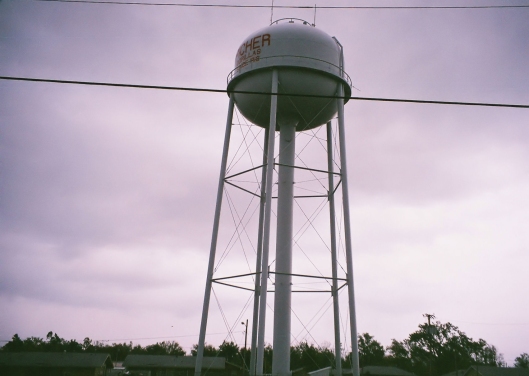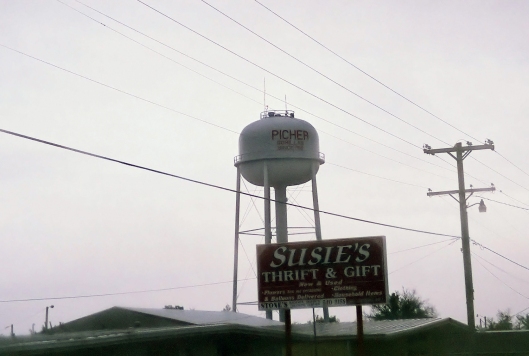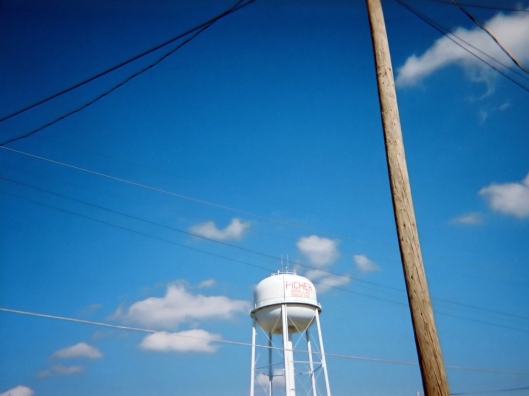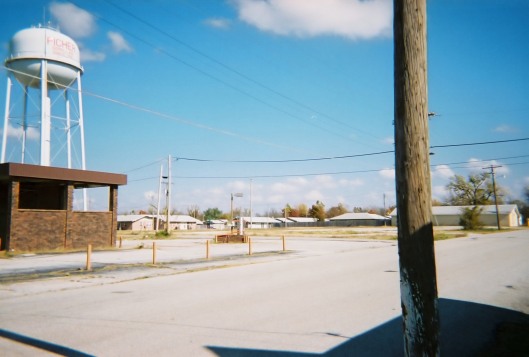Tags
buyouts, chat piles, ghost town, Hoppy Ray, JD Sutter, Joplin Globe, lead mining, photography, Picher, Picher Gorillas, Picher Oklahoma, Picher tornado, Tar Creek Superfund Site, water tower, zinc mining
This Sunday Still comes with a story. I hope you have time to listen.
I love water towers. They’re the very essence of small town life. Kids paint their names on them, declare love on them, climb them for kicks. They bear the mascot of the home team, the name of the town, and the pride of the people in it. They serve a purpose and fill a need beyond water storage, and after so many years of driving by them they become landmarks, beacons, friendly faces– all of which we associate with home.
But this particular water tower doesn’t have much of a home anymore. Its job of watching over a ghost town– providing water to what is less than two hundred– must be pretty depressing at times. It’s less than a decade old; proud, white, and hard to miss with its big red letters burning in the Oklahoma sun. Picher, home to the Gorillas since 1918. And in all the years I’ve known it, I haven’t once seen it falter, or even start to fade.
When the May 10th tornadoes blew through town in 2008, it remained untouched. When the government declared there was no hope for Picher and one by one houses and businesses began to disappear, it remained. The water tower remained even though the high school is closed now and the Gorillas haven’t played a game in seven years. Even though the population of the town it serves gets marginally slimmer with each passing month, the water tower is still there. Waiting. For the end pessimists say is coming, and the one optimists are convinced never will.
Despite what they say– Picher is a charmed place. It looks like it’s still stuck in the Fifties, with its whitewashed churches and hamburger joints tattooed with retro Coke signs. There is something odd about it, though. Something amiss that even a total stranger could pick up on. When an out-of-state car comes barreling through on HWY 69, it slows down when it reaches the outskirts of the town. For lack of a better explanation, they’re probably looking at the unnatural white mountains of gravel or “chat” that darken the horizon.
Or it could be something else; maybe that feeling you get when it hits you that every storefront is empty. The park is overgrown with weeds, and the asphalt on the sun-tanned streets is thin and cracked. Neon open signs no longer flash. Vacant lots are scattered here and there, where buildings once stood. Main Street is about half empty now, stretching out like a gap-toothed grin on the dusty face of the town time and progress forgot.
You see– Picher, Oklahoma is a mining town. Or at least it was, before the lead and zinc operations closed in the late 1970s. When the mining companies packed up and moved out, roughly 20,000 of the town’s residents were left with nothing but a certificate of unemployment and acres of empty ground beneath their feet. After years of prosperity, their memories and their fortunes rested within the mine tailings– smelted gravel leftover after the extraction of lead and zinc deposits. Those bone-white piles of “chat” left looming around town were embraced as a part of the culture in Picher, until the EPA discovered dangerously high levels of lead in the air and water. With the mines closed, loose chat had to be the culprit. The white dust that blew off the piles on a daily basis was loaded with deadly minerals like cadmium and zinc. It couldn’t be cleaned up, and soon the government began buying out homes and working toward “closing the town” for good.
But how do you ever really close a town? Even in her demise, Picher finds a reason to smile. She has been condemned for so long that it doesn’t even seem to matter anymore. The ones that wanted to stay have stayed, and now go about their daily lives with their shoulders hunched against the government’s threats of foreclosure. They have never been scared of the poison in the air. How can they be? They grew up drinking Picher’s “hard” red water and watching the world turn from atop a favored hill of chat. There are no banks, grocery stores, or restaurants within the city limits– but still the last few citizens remain.
In case you were wondering how I fit into all this, I’m not from Picher or even Oklahoma. Still, I’ve proudly carried a banner for the faded world amongst the white mountains for about two years now. When it comes right down to it I guess I’m little more than a visitor when I make a trip to the extreme northeastern corner of Oklahoma, to see old Hoppy Ray and take pictures of that brave water tower. But even so, I can still close my eyes and remember a sweeter time– back when our hearts, and the mines, were open.
The shots below were taken with a disposable point-and-shoot! (Just tell yourself that it lends the photos a nice, dreamlike quality and we’ll be OK.) 😉




For more on Picher, the Tar Creek Superfund Site, and the 2008 tornado, you can visit the links below and some of the ones in my sidebar.
Picher Twister.
An Interview with Hoppy Ray.
For more from me on Picher, my journeys there, Hoppy Ray, pastimes, pool halls, and Joe Don Rooney please visit my previous posts concerning the topic.

thecrazysheeplady said:
Great story. Very well written. You could have posted it without the pictures and it would have counted.
Trapper Creek Daughter said:
You know I love it, Meg!
flowerweaver said:
Neat story! I liked the one about Hoppy Ray, too. Maybe I just have a soft spot for ghost towns, since I live in one myself. Population 49.
Holly said:
wow. what a great story. I think this is one of the things I love best about the SSC, the stories that go with the photos.
Ed said:
Very nice and the story is great also, you deffinatly have a way with words..:-)
Laughing Orca Ranch said:
This was fun. Thanks for the story along with the pics.
Pretty good with a disposable, too.
~Lisa
Kelly said:
Nice pictures and a great story to go with!
Terry Gene Hembree said:
Hello
Thank you for the mention on your blog
The Picher water tower images are great
Keep up hte good work
Anything I may offer to assist you, please dont hesitate to contact me
Terry
rachel said:
The blue blue sky really made that water tower pop!